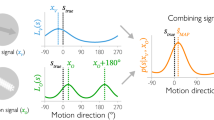Abstract
In this chapter we describe how the simple heuristic maintain egocentric direction of the target and the associated heuristic cancel target drift can, in theory, be used to successfully visually guide an observer around an environment. The motivation for this chapter is the proposal by Rushton et al. (1998) that observers visually guide locomotion using perceived egocentric target direction rather than optic flow. We concentrate on the visual control aspects of self-motion. The other approach is to develop models that capture the walking behavior of an observer attempting to reach a target. These models describe the final avoidance or closure behavior, rather than just the visual control laws themselves. Therefore they include terms such as a “damping” parameter and take into account perceptuo-motor processing delays. These terms reflect the physical embodiment of the observer, specifically, the physical limitations of the observer. An observer can only process information so fast, and the observer’s body has a mass whose velocity must be regulated.
Access this chapter
Tax calculation will be finalised at checkout
Purchases are for personal use only
Preview
Unable to display preview. Download preview PDF.
Similar content being viewed by others
References
Bootsma, R. J. (1991). Predictive information and the control of action: what you see is what you get, Int. J. Sports Psychol., 22, 271 - 278.
Gibson J. J. (1958). Visually controlled locomotion and visual orientation in animals, Br. J. Psychol., 19, 182 - 194.
Land, M. F. (1998). The Visual Control of Steering. In: Harris, L. R. & Jenkin M. (Eds). Vision and Action. Cambridge University Press.
Land, M. F. & Collett, T. S. (1974). Chasing behavior of houseflies (Fannia canicularis). A description and analysis, J. Comp. Physiol., 89, 331 - 357.
Land, M. F. & Lee, D. N. (1994). Where we look when we steer, Nature, 369, 742 - 744.
Lee, D. N. (1976). A theory of the visual control of braking based on information about timeto-collision, Perception, 5, 437 - 459.
Lee, D. N. (1998). Guiding movement by coupling taus, Ecol. Psychol., 10, 221-250. Llewellyn K. R. (1971). Visual guidance of locomotion, J. Exp. Psychol., 91, 245 - 261.
Loomis, J. M. & Beall, A. C. (1998). Visually controlled locomotion: its dependence on optic flow, three-dimensional space perception and cognition, Ecol. Psychol., 10, 271 - 285.
Peper, L., Bootsma, R. J., Mestre, D. R. & Bakker, F. C. (1994). Catching balls: how to get the hand to the right place at the right time, J. Exp. Psychol. Hum. Percept. Perform., 20, 591 - 612.
Rushton, S. K., Wen, J. & Allison, R. S. (2002). Egocentric Direction and the Visual Guidance of Robot Locomotion: Background, Theory and Implementation. In: Billthoff, H. H., Lee, S. W., Poggio,T. A. & Wallraven, C. (Eds). Biologically Motivated Computer Vision: Lecture Notes in Computer Science (pp. 576-591), Springer.
Rushton, S. K., Harris, J. M., Lloyd, M. L. & Wann, J. P. (1998). Guidance of locomotion on foot uses perceived target location rather than optic flow, Curr. Biol., 8, 1191 - 1194.
Rushton, S. K. & Wann, J. P. (1999). Weighted combination of size and disparity: a computational model for timing a ball catch, Nat. Neurosci., 2, 186 - 190.
Thompson, D. A. (1966). On Growth and Form. Cambridge,England: Cambridge University Press.
Strelow, E. R. & Brabyn, J. A. (1981). Use of foreground and background information in visually guided locomotion, Perception, 10, 191 - 198.
Wann, J. P. & Land, M. F. (2000). Steering with or without the flow: is the retrieval of heading necessary? Trends Cogn. Sci., 4, 319 - 324.
Author information
Authors and Affiliations
Editor information
Editors and Affiliations
Rights and permissions
Copyright information
© 2004 Springer Science+Business Media Dordrecht
About this chapter
Cite this chapter
Rushton, S.K., Harris, J.M. (2004). The Utility of not Changing Direction and the Visual Guidance of Locomotion. In: Vaina, L.M., Beardsley, S.A., Rushton, S.K. (eds) Optic Flow and Beyond. Synthese Library, vol 324. Springer, Dordrecht. https://doi.org/10.1007/978-1-4020-2092-6_16
Download citation
DOI: https://doi.org/10.1007/978-1-4020-2092-6_16
Publisher Name: Springer, Dordrecht
Print ISBN: 978-90-481-6589-6
Online ISBN: 978-1-4020-2092-6
eBook Packages: Springer Book Archive




